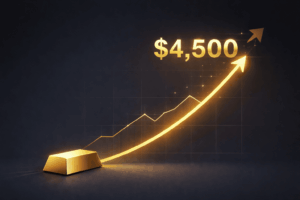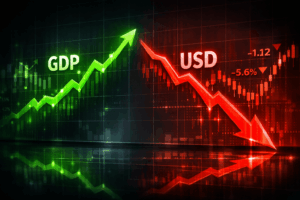Mike Maloney just made his boldest silver prediction yet: “I’m betting on at least $200 an ounce, but we could see a spike that goes up toward quadruple digits.”
That’s not hyperbole. It’s based on a fascinating pattern emerging across three continents—one that suggests silver is undergoing a fundamental transformation from “just an industrial metal” to something far more significant.
In a recent episode of the Gold & Silver Show, Mike and analyst Alan Hibbard tackled a question posed by a conference attendee in New Orleans: Are central banks starting to buy silver? And if so, will it trigger a snowball effect that sends prices parabolic?
The answer might surprise you. It’s already happening.
Three Central Banks Are Leading the Charge
Russia became the first nation to explicitly announce silver purchases for state reserves, allocating over $500 million across three years. As Alan notes: “If the gold-silver ratio goes down to 20, they’ll be able to get over two trillion worth of gold for this $535 million spent on silver.”
Saudi Arabia’s central bank invested $40 million into silver ETFs. While Mike openly distrusts ETFs—”I read their prospectus and their 10K filings”—the significance isn’t how they bought it. It’s that they bought it at all.
India made silver eligible as collateral for loans, just like gold. The Reserve Bank set a 10:1 ratio compared to gold, even though the current market ratio sits around 85:1. “It tells you where they think it might be going,” Mike observes.
Silver Is Becoming a “National Security Metal”
Even more telling than direct purchases is how governments are classifying silver.
China will restrict silver exports starting in 2026, requiring licenses for any silver leaving its borders. The United States added silver to its list of critical minerals in 2025. Australia named silver as one of just five priority metals in its 10-year critical minerals strategy.
As one commentator summarized: “Three continents, same signal. Silver isn’t just an industrial metal anymore. It’s becoming a cornerstone of national security and energy transition.”
Mike’s take? “It’s developing a monetary component right now. And that is what is required for the triple-digit silver that I believe is definitely in our future.”
The Supply Crisis Nobody’s Talking About
The world is using far more silver than it produces. Shanghai exchange data shows Chinese silver inventories collapsing over the past five years. The same pattern is playing out globally.
“People are taking delivery,” Mike explains. “People are not trusting the paper contracts as much as actually having it in their hands.”
Add the explosion in AI infrastructure, solar panels, electric vehicles, and advanced electronics—all requiring silver—and you have a perfect storm.
“I don’t know if even at $150 or $200 an ounce if silver is going to catch up with demand,” Mike admits. “You look at the AI infrastructure being built out… and at the same time people are rushing back to it for investment.”
History Says Silver Could Hit $661… Or Much Higher
Alan presented a chart comparing today’s silver bull market to the 1970s. Adjusted for dollar devaluation, the pattern suggests a potential target around $661 per ounce.
But even that might be conservative.
In Mike’s book The Great Gold and Silver Rush of the 21st Century, they analyzed percentage changes from January 1980 to today:
- If silver matched the Wilshire 5000: $2,178 per ounce
- Average across CPI, home prices, GDP, M2: $921 per ounce
- The chart’s “echo” target: $661 per ounce
“I don’t think this $661 is unreasonable,” Mike says. Alan’s even more bullish: “I do think we are going to get a massive blowoff top in the next two to three years going up to something like $600 an ounce.”
The Bottom Line
When Russia, India, and Saudi Arabia start positioning in silver—and when China, the U.S., and Australia simultaneously restrict or prioritize it—you’re watching a fundamental shift in real time.
Silver is transforming from an industrial commodity into a strategic asset. Part national security metal. Part monetary hedge. Part irreplaceable tech component.
“We used to be on a bimetallic standard, and maybe we’re going back to one,” Mike notes. “Silver gives you that leverage to gold, and central banks have to realize it.”
The recent pullback? Investors sat on the sidelines. It’s the same pattern every cycle: silver dips, nobody buys. Silver runs, everyone panics to get in. As analyst Carrie Stevenson puts it: “When shoes are on sale, women are fighting to buy those shoes. When gold and silver are on sale, you can’t get anybody to buy it.”
The difference this time? Central banks are in the game. Governments are restricting supply. And the structural deficit isn’t going away.
Watch the full video here to see Mike and Alan’s complete analysis—including the historical chart pattern suggesting silver could hit $600+ in the next 2-3 years, and why the window to position yourself may be closing faster than you think.
People Also Ask
Why does Mike Maloney believe silver could hit $200 an ounce or higher?
Mike bases his $200 silver prediction on rising central bank demand, shrinking global supply, and silver’s growing role in energy and technology sectors.
Which central banks are already buying silver?
Russia, India, and Saudi Arabia have all begun acquiring silver—through direct purchases, ETFs, and collateral programs—signaling a major shift in monetary policy.
Why is silver being called a “national security metal”?
Governments like China, the U.S., and Australia now classify silver as critical to national security because it’s essential for energy, defense, and high-tech manufacturing.
How does silver demand compare to supply right now?
Global silver demand far exceeds mine production, with inventories collapsing across major exchanges as investors and industries take physical delivery.
What could silver’s long-term price potential be based on historical patterns?
Adjusted for inflation and past bull markets, silver could reach between $661 and $2,000 per ounce, according to Mike Maloney and Alan Hibbard’s analysis.
Get Gold & Silver Insights Direct to Your Inbox
Join thousands of smart investors who receive expert analysis, market updates, and exclusive deals every week.








